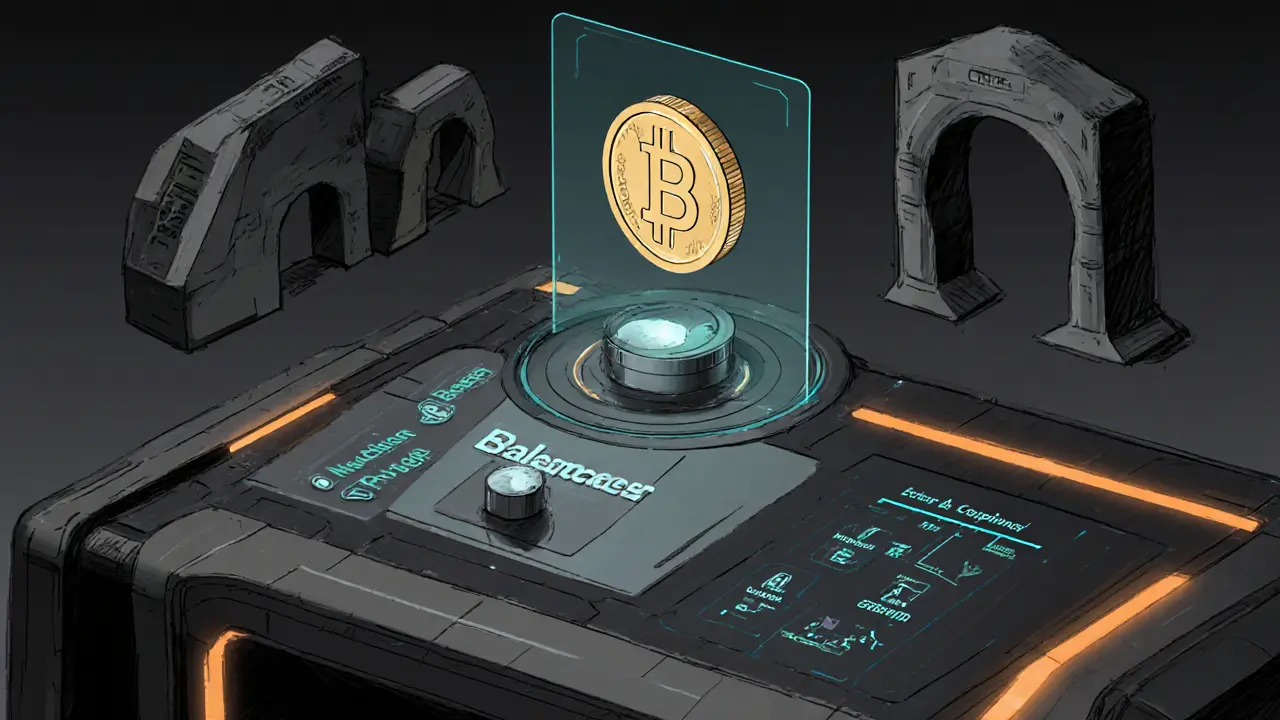Balancer v2 Pool Fee Calculator
Weighted Pool
Flexible token mixes with custom weights
Stable Pool
Low-slippage for pegged assets
Fee Calculation Results
Enter values and click calculate to see potential fees.
TL;DR
- Balancer v2 lets you build custom multi‑token pools (up to 8 tokens) with programmable weights.
- Fees range from 0.001% to 10% for weighted pools and 0.0001% to 10% for stable pools, making it one of the most fee‑flexible DEXs.
- TVL sits around $1.2billion and daily volume averages $120million as of April2025.
- Pros: high capital efficiency, boosted‑pool yield hooks, deep DeFi integrations.
- Cons: lower security score (2/10 from Traders Union), steep learning curve, no traditional support channels.
Balancer is a decentralized exchange and automated market maker (AMM) built on Ethereum that launched in September2019. The platform’s second generation, Balancerv2, introduced programmable liquidity, multi‑token pools, and a suite of yield‑optimisation hooks that set it apart from simpler two‑token AMMs like Uniswap.
How Balancer v2 Works
At its core, Balancer replaces a traditional order book with smart contracts that hold pools of assets. Each pool can contain up to eight ERC‑20 tokens, each assigned a custom weight (e.g., 50% ETH, 30% DAI, 20% WBTC). Prices adjust automatically based on the ratio of tokens in the pool, following the constant‑function‑market‑maker formula. This design improves capital efficiency because a single pool can serve dozens of trading pairs without needing a separate pool for each pair.
Two pool types dominate the ecosystem:
- Weighted pools - flexible token mixes with user‑defined weights, ideal for portfolio‑style liquidity provision.
- Stable pools - low‑slippage pools for assets that track the same value (e.g., USDC/USDT), using tighter curve parameters.
When you submit a swap, Balancer routes the trade through its Smart Order Routing (SOR) engine. The SOR scans all available pools, picks the best price, and splits the trade across multiple pools if needed. This reduces slippage and often lands you a better rate than a single‑pool swap.
Boosted pools and hooks let liquidity providers (LPs) earn extra yield by directing idle capital to third‑party strategies (e.g., Aave lending, Lido staking) without withdrawing from the pool. The earned rewards are automatically distributed back to LPs, increasing overall APR while keeping the pool liquid for traders.
Fees, TVL, and Trading Volume
Balancer’s fee model is one of the most granular in DeFi. Pool creators set a fee within prescribed ranges:
- Weighted pools: 0.001% - 10%
- Stable pools: 0.0001% - 10%
Fees are taken from each swap and can be split between LPs, protocol treasury, and any custom fee recipients. The flexibility lets projects attract high‑frequency traders with low fees or incentivise deep liquidity with higher fees.
As of April2025, Balancer’s Total Value Locked (TVL) sits at roughly $1.2billion across Ethereum and its multichain extensions (Arbitrum, Base, Polygon). Daily trading volume averages $120million, with peak spikes during major DeFi events (e.g., token launches, governance votes). This positions Balancer behind Uniswap (≈$4billion TVL) and Curve (≈$4billion TVL for stablecoins) but ahead of many niche AMMs.
Pros and Cons
What makes Balancer stand out?
- Programmable liquidity - custom weights and pool compositions give LPs unprecedented control over risk/reward.
- Yield hooks - ability to earn extra returns without leaving the pool.
- Deep DeFi integration - native connections to Aave, Lido, Rocket Pool, and Aura Finance boost composability.
- Transparent governance - veBAL voting and Snapshot2.0 provide on‑chain and off‑chain decision pathways.
Where the platform falls short
- Security rating of 2/10 from Traders Union raises red‑flag concerns about audits and regulatory compliance.
- Complex UI and terminology create a steep learning curve for newcomers.
- No traditional customer support; users rely on Discord, community docs, and self‑service.
- Liquidity can be fragmented across many custom pools, sometimes leading to higher slippage for small traders.

Balancer vs. Other DEXs
Below is a quick side‑by‑side look at how Balancer stacks up against three of its biggest competitors.
| Metric | Balancer | Uniswap | Curve | SushiSwap |
|---|---|---|---|---|
| TVL (USD) | $1.2B | $4B+ | $4B+ | $400M |
| Daily Volume (USD) | $120M | $650M | $300M | $90M |
| Pool Types | Weighted & Stable (up to 8 tokens) | 2‑token constant‑product | Stable‑coin focused | 2‑token + limited multi‑token |
| Fee Range | 0.0001% - 10% | 0.05% - 1% | 0.0001% - 0.04% | 0.03% - 1% |
| Yield Hooks | Yes (boosted pools) | No | No | No |
| Security Score (Traders Union) | 2/10 | 7/10 | 8/10 | 6/10 |
The BAL Token and Governance
The native utility token, BAL (governance token for Balancer), has a capped supply of 96million. Around 64million are in circulation, and the token is used to reward LPs, pay protocol fees, and participate in governance.
Balancers’ governance model revolves around veBAL (vote‑escrowed BAL). Holders lock BAL for up to four years, receiving voting power proportional to lock duration. veBAL decides on fee parameters, protocol upgrades, and the allocation of newly minted BAL. In 2025, over 50% of veBAL votes were delegated through markets run by Redacted Cartel and StakeDAO, highlighting the growing influence of delegation services.
In parallel, Aura Finance acts as a meta‑governance layer, allowing veBAL holders to boost their rewards by staking into Aura’s ve‑token vaults. This synergy has helped push LP APRs into double‑digit territory on certain boosted pools.
Security and Compliance Outlook
Even though Balancer’s codebase has undergone multiple audits (by OpenZeppelin, ConsenSys Diligence, and Trail of Bits), the platform’s composite architecture-custom hooks, external yield strategies, and multichain bridges-expands the attack surface. Traders Union’s 2/10 score reflects concerns around complex upgrade pathways and the lack of a formal compliance framework. For institutions, this means a higher due‑diligence burden.
On the bright side, Balancer’s governance upgrades in 2025 introduced Snapshot2.0 for transparent off‑chain voting, and the newly formed Multichain Coordination Council is tasked with overseeing cross‑chain risk management. These steps suggest a proactive stance toward security, but users should still monitor audit reports and keep a modest exposure.
User Experience: What You’ll Actually Do
To start swapping or providing liquidity, you connect a non‑custodial wallet (MetaMask, Ledger, or Coinbase Wallet). There’s no account creation, KYC, or email required-just sign a transaction to approve token transfers. The UI groups pools by type and shows real‑time APR, fee tier, and pool composition.
Minimum deposit is effectively $1 worth of any supported ERC‑20 token, but the practical minimum depends on pool depth; tiny trades in shallow pools can suffer noticeable slippage. There is no leverage, PAMM accounts, or affiliate program, reinforcing Balancer’s focus on pure DeFi infrastructure.
Support is community‑driven: Discord, Twitter/X, and an extensive docs site. While the documentation is thorough, it assumes familiarity with AMM maths, token weight concepts, and Ethereum gas mechanics. Beginners may need to spend a few hours reading before feeling comfortable.
Future Roadmap and Outlook
Balancer’s roadmap for the next 12‑18 months includes:
- Expanding boosted‑pool hooks to cover more yield protocols (e.g., Radiant, Camelot).
- Launching a native layer‑2 rollup solution to slash gas fees for small traders.
- Furthering multichain integration with full‑featured pools on Arbitrum, Base, and Polygon, targeting an additional $500million TVL.
- Implementing a formal compliance module that can flag transactions for AML/CTF monitoring-aimed at attracting institutional capital.
If security concerns are addressed and the multichain push gains traction, Balancer could solidify its niche as the go‑to platform for programmable liquidity and advanced yield strategies. Retail adoption may stay limited due to complexity, but the DAO and institutional segments are likely to grow.

Frequently Asked Questions
What is the main advantage of Balancer’s multi‑token pools?
A single pool can hold up to eight different assets with custom weightings, so you can trade many pairs and earn fees from multiple markets without needing separate pools for each pair.
How do Balancer’s fees compare to Uniswap?
Balancer lets pool creators set fees as low as 0.0001% for stable pools, whereas Uniswap’s fee tiers start at 0.05% and go up to 1%. This makes Balancer more flexible for low‑slippage, high‑frequency trading.
Is Balancer safe to use?
The core contracts have been audited multiple times, but the platform’s complexity and low security score mean you should limit exposure and stay updated on audit reports.
Do I need to hold BAL tokens to provide liquidity?
No. You can add any ERC‑20 tokens to a pool without owning BAL. However, staking BAL (or veBAL) can boost your rewards on certain pools.
Can I trade on Balancer from a mobile device?
Yes. The web UI is responsive and works with mobile wallets like MetaMask Mobile or Trust Wallet. Transactions still need to be signed in the wallet app.

